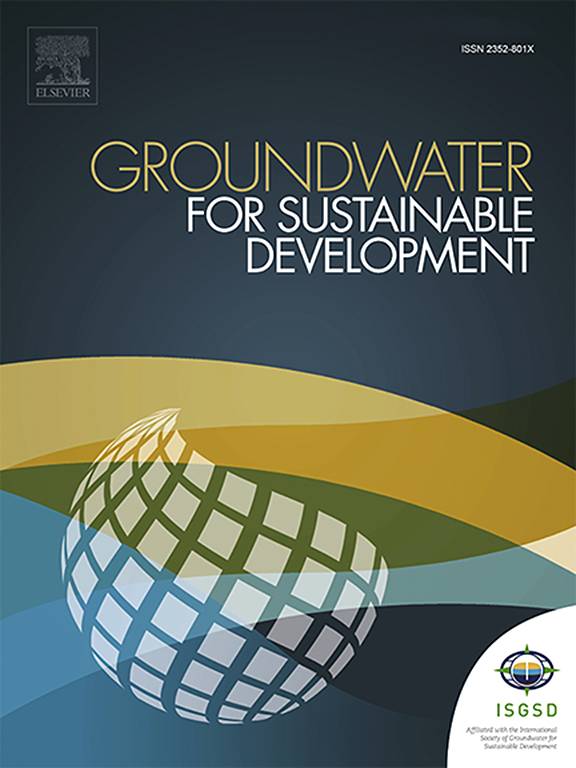Integrating aquifer vulnerability and explainable machine learning for spatial prediction of groundwater fluoride
IF 4.9
Q2 ENGINEERING, ENVIRONMENTAL
引用次数: 0
Abstract
Groundwater fluoride (F−) contamination has serious risks to public health and environmental sustainability. This study enhances spatial prediction of fluoride concentration (SPFC) in the Ordos Basin, northwest China, by applying a Light Gradient Boosting Machine (LGBM) model integrated with SHapley Additive exPlanations (SHAP) analysis. A total of 26 hydrological, geological, environmental, climatic, hydro-chemical, and anthropogenic indicators were incorporated. Key findings reveal that high fluoride concentrations (>1 mg/L) cover approximately 17.48 % of the basin, while moderate (0.5–1 mg/L) and low (<0.5 mg/L) concentrations account for 39.05 % and 43.47 % of the area, respectively. The LGBM model demonstrated high predictive accuracy with R2 values of 0.9180 for the training set and 0.7579 for the validation set, and RMSE values of 0.0582 and 0.0748, respectively. SHAP analysis identified significant contributors to F− contamination, including hydro-chemical indicators (CMSH: 9.09 %, SAR: 5.45 %, TDS: 5.97 %, Na+: 5.71 %, pH: 4.94, Ca2+: 4.68 % and CAI: 4.68 %), socio-economic factors (population density: 5.19 % and GDP: 5.19 %), topographic factors (elevation: 4.42 %, TWI: 7.53 % and proximity to rivers: 6.75 %) and NDVI (4.94 %). Finally, an innovative matrix-based sustainable groundwater management (SGWM) framework was developed, integrating SPFC, IAV and groundwater storage (GWS) to delineate seven distinct management zones. This comprehensive approach from SPFC to SGWM significantly enhances the predictive accuracy and practical applicability of groundwater management strategies, providing a robust tool for addressing F− contamination and supporting the achievement of global health and environmental sustainability goals under the sustainable development goals (SDGs).

基于含水层脆弱性和可解释性机器学习的地下水氟化物空间预测
地下水氟化物污染对公众健康和环境可持续性具有严重风险。采用结合SHapley加性解释(SHAP)分析的光梯度增强机(LGBM)模型对鄂尔多斯盆地氟浓度(SPFC)进行空间预测。共纳入了26项水文、地质、环境、气候、水化学和人为指标。重点发现:高氟(1 mg/L)覆盖流域面积约17.48%,中度(0.5 ~ 1 mg/L)和低氟(0.5 mg/L)分别占39.05%和43.47%。LGBM模型具有较高的预测准确率,训练集和验证集的R2分别为0.9180和0.7579,RMSE分别为0.0582和0.0748。SHAP分析确定了F -污染的重要因素,包括水化学指标(CMSH: 9.09%, SAR: 5.45%, TDS: 5.97%, Na+: 5.71%, pH: 4.94, Ca2+: 4.68%, CAI: 4.68%),社会经济因素(人口密度:5.19%,GDP: 5.19%),地形因素(海拔:4.42%,TWI: 7.53%,靠近河流:6.75%)和NDVI(4.94%)。最后,开发了一个创新的基于矩阵的可持续地下水管理(SGWM)框架,将SPFC、IAV和地下水储存(GWS)整合在一起,划定了七个不同的管理区域。这种从SPFC到SGWM的综合方法显著提高了地下水管理战略的预测准确性和实际适用性,为解决氟污染问题和支持实现可持续发展目标(SDGs)下的全球健康和环境可持续性目标提供了强有力的工具。
本文章由计算机程序翻译,如有差异,请以英文原文为准。
求助全文
约1分钟内获得全文
求助全文
来源期刊

Groundwater for Sustainable Development
Social Sciences-Geography, Planning and Development
CiteScore
11.50
自引率
10.20%
发文量
152
期刊介绍:
Groundwater for Sustainable Development is directed to different stakeholders and professionals, including government and non-governmental organizations, international funding agencies, universities, public water institutions, public health and other public/private sector professionals, and other relevant institutions. It is aimed at professionals, academics and students in the fields of disciplines such as: groundwater and its connection to surface hydrology and environment, soil sciences, engineering, ecology, microbiology, atmospheric sciences, analytical chemistry, hydro-engineering, water technology, environmental ethics, economics, public health, policy, as well as social sciences, legal disciplines, or any other area connected with water issues. The objectives of this journal are to facilitate: • The improvement of effective and sustainable management of water resources across the globe. • The improvement of human access to groundwater resources in adequate quantity and good quality. • The meeting of the increasing demand for drinking and irrigation water needed for food security to contribute to a social and economically sound human development. • The creation of a global inter- and multidisciplinary platform and forum to improve our understanding of groundwater resources and to advocate their effective and sustainable management and protection against contamination. • Interdisciplinary information exchange and to stimulate scientific research in the fields of groundwater related sciences and social and health sciences required to achieve the United Nations Millennium Development Goals for sustainable development.
 求助内容:
求助内容: 应助结果提醒方式:
应助结果提醒方式:


